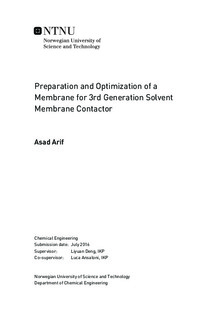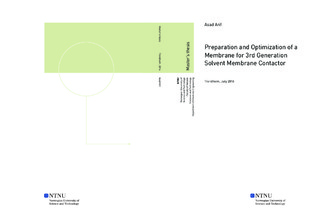| dc.description.abstract | Third generation solvent is a new class of CO2 absorbents with a great potential in terms of reduction of the regeneration energy requirement for post combustion carbon capture, but their use at the industrial scale is limited by their high volatility. Membrane contactor technology is proposed as possible solution, but the membrane layer must be purposely designed in order to act as amine barrier, without negatively affecting the overall CO2 mass transfer resistance. Teflon AF2400 has been reported to be a suitable membrane material, but an improvement of its properties is required to achieve better performance of the membrane contactor.
Herein, a systematic study was performed to investigate mass transport properties of the main components present in the separation process (CO2, H2O and amine molecules) in mixed matrix membranes (MMMs) based on Teflon AF2400. Different MMMs were prepared by inclusion of inorganic materials (graphene, reduced graphene oxide and ZIF-8) in the polymeric matrix. In particular, the effect of different loadings (from 2 to 10%) has been investigated. The obtained membrane were characterized in terms of morphology, through high-resolution scanning electron microscopy, and transport performances, through pure gas (CO2 and N2) permeation experiments. The membrane with higher nanoparticles loadings displayed promising results.
According to the CO2 permeability results, the membrane obtained by embedding 7.5 wt % ZIF-8 within the matrix was selected for further characterization in terms of amine transmembrane flux. To this purpose a pervaporation setup was used, which allows the investigation of pure chemicals as well as liquid mixtures. The results obtained from pervaporation experiments showed that the MMM developed in this work was able to achieve a, an CO2/amine ideal selectivity of 763 at 40 °C, 378 at 50 °C and 212 at 60 °C. In comparison with the pure polymer membrane, the CO2/amine selectivity of this MMM is almost 2 times higher at 40°C, and even further improvement is obtained at 60 °C.
In order to improve the understating of the fundamental transport mechanism of amines through polymer layer sorption experiments were performed at 35 °C for the pure components of the liquid mixtures (H2O, DEEA and MAPA). The solubility for MAPA and DEEA was found to be always below 0.005 g/gpol in an activity range that would correspond to the one in the liquid mixture. These low solubility values are in line with the low permeation rate for amines obtained from the pervaporation experiments. | |

